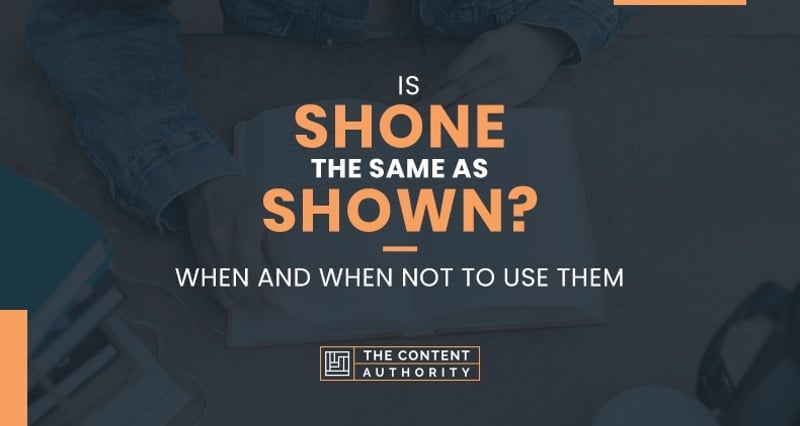Conjugating a term or using its variation is a tricky proposition, especially if you’re not sure about a given word variant being correct or not. For example, a fair number of writers get confused between “shone” and “shined”. But let’s talk about “shone” and “shown” before that.
The terms “shone” and “shown” are anything but words with identical or similar meanings. “Shone” is “shine’s” past participle. The word “shown” is the past tense variant of the verb “show”, and not the noun. “Shine” has another past participle in “shined”, which, however, is not as commonly used.
When discussing “shone” and “shown”, it’s important to talk about a few other terms. In this article, the major differences between “shone” and “shown”, how to use them in sentences, etc., have been discussed in great detail. Read on!
“Shone” – Definition

The word “shone” is “shine’s” past tense. It means “giving off light”, “beaming”, “glowing”, etc. The term is typically used in reference to the sun, but it could also be used in other contexts. “Shone” can also denote “light being reflected”, “someone excelled at something”, or “a surface or floor was polished”.
The term “shone” has its roots in the Old English term “scinan”, which means “be radiant”, “shed light”, “illuminate”, etc. Words close to or similar in meaning to “shone” include “dazzle”, “glisten”, “beam”, “twinkle”, “shimmer”, “glitter”, “radiate”, “glare”, “sparkle”, etc.
Is “Shined” a Past Tense of “Shine” Too?
“Shine” has a couple of words serving as its past tense forms: “shone”, and “shined”. “Shined” is a transitive verb that means “to excel”, “to emanate light”, “to glint or glisten”, “to reflect light”, etc. It could also mean “polished” or “to be apparent immediately”.
“Shown” – Definition
“Shown” means “to exhibit”, “make noticeable”, “to bestow”, “to present”, etc. “Shown” is the word “show’s” past participle. “Showed” is an acceptable word or could be the other past tense form of “show”.
“Show” is both a noun and a verb that has been around as a valid English term since the 1300s. During the early 16th century, the word assumed another meaning, “putting on an appearance with the intent to deceive”. Later, during the 18th century, “show” also meant “ostentatious display”.
“Shown” became a prominent word in English only during the 19th century. Prior to that, other variations of the word were believed to be used. In fact, “show” was once “shew”, and its past participle was “shewed”. The origin of “shew”, how “shewed” came to be, how they are now obsolete, etc., are not very clear or well-documented.
“Shown” or “Showed”?
As mentioned above, “shown” is the more commonly used past participle of “show”. But before “shown”, there was “showed”. Also, “showed” is still in circulation, but not as much as “shown”. (More on the comparison between the two later in the article)
Using “Shone” in Texts
As mentioned above, the term “shine” can be used in reference to a thing that isn’t the sun, such as artificial lights, hair, eyes, etc. For example:
- Her hair doesn’t have that shine anymore.
- He took the shine off the ball.
As a result, the word’s past tense form could also be used with zero mentions of celestial bodies. For example:
- She brushed her mane until it shone.
- His eyes shone as the topic of love was brought up.
- When the candidate won the debate, his eyes shone.
Using “Shined” or “Shone”?

A transitive verb is a verb that has an object. In other words, the “action” is being carried out by something or someone and to someone or something. An intransitive verb also has a subject, but it has no object, or it’s not directed at anyone or anything.
Since it’s transitive, “shined” should be used when the sentence has a verb and an object to boot. When there’s no object, use “shone” instead. For example:
- He shined his car’s headlights at the house as it was pitch dark, and he wasn’t carrying a torch.
- His face shone with blissful joy.
In the first sentence, the object is the house.
Another example sentence:
- She shined her hair.
The object above is “hair”.
Here are a couple more sentences that use “shined” correctly:
- The car detailing professional shined the paint.
- Mark shined his shoes.
Since the verb “shone” is intransitive, it won’t fit into either of the sentences above. Here is a sentence that can use “shone”:
- The sun shone brightly that day.
“Shone” is typically used in conjunction with “forth”, “on”, “from”, and similar prepositions.
Remembering When and How to Use “Shined” and “Shone”
If the “verb-object” rule seems a bit complex to ascertain when and when not to use “shined” or “shone” in your texts, a mnemonic trick may help.
“Shone” has the letters “n” and “o”, or “no”. The “no object” condition for “shone” has “no” as well. Use this connection to your writing benefit.
“Shone” also rhymes with “alone”, which could be used as a cue to remember “shone” is used when it’s “alone” or without an object in a sentence.
Using “Shown” in Writings
As stated above, “shown” is “show’s” past participle. The following is an example of a sentence modified slightly to accommodate “shown” and “show”, respectively:
- Korean movies are rarely shown there.
- The theater rarely shows Korean movies.
As briefly discussed above, it can be a toss-up between “shown” and “showed”. In countries like the U.K., “showed” is considered dialectal or archaic. In the United States, it’s a standard variant of “show”, but not as widely used as “shown”.
Though “shown” is more commonly used, there are scenarios in which “showed” fits in better than “shown.
In other words, to ascertain when to use “shown” and when to employ “showed”, phrasal verb rules may apply. If another word in a sentence accompanies ” show”, the past perfect tense will use “showed” and not “shown”. For example:
- Did she show up?
- She showed up.
It cannot be, “She shown up“.
“Showed” is invariably used with verbs such as “had” and “have”. It doesn’t, however, fit well in passive sentences.
For example:
- The match was showed live.
Instead, “The match was shown live” reads a lot better. To incorporate “showed”, the above sentence should be framed as:
- They showed the match live.
“They shown the match live” is incorrect.
Here is another set of sentences comparing the two:
- She was showed the exit. (awkward)
- She was shown the exit. (a lot better)
Here are the correct uses of the two verbs:
- The movie was first shown in the theater in 2002.
- The movie first showed in the theater in 2002.
As made clear above, “showed” works in direct sentences a lot better. The “subject”, however, matters or ascertains how well “showed” fits in there.
What About “Shew”, “Shewed”?
Though “shew” and “shewed” have been valid terms in the past, and despite not deemed incorrect, they may not fit well in the modern lexicon like they might have blended into the language several centuries or even decades ago.
And, as mentioned above, “show” can be a noun too. When “show” is incorporated as a noun, both “shown” and “showed” do not enter the room as both modify the verb “show” only.

Example Sentences with the Term “Shone”
The following are sentences using “shone” correctly:
- Her hair shone as if it was coated in oil, which it wasn’t.
- They rose to shone light on him.
- The doctor lifted one of her eyelids and shone a light on it to check for any abnormalities.
- The sun shone pretty much all day.
- The talented girl had shone in show business for close to a decade before things started falling apart for her.
- The cops shone spotlights on him as he opened the gate.
- The sun shone.
- Delight shone in his eyes.
- She shone the torch in his eyes.
- The reality shone out of her words.
- She shone in athletics.
Example Sentences with the Word “Shown”
Here is a list of sentences with the term “shown” in them:
- He had shown us his collection of currency coins and stamps.
- The first television program shown in the country was The Queen’s Messenger.
- Live television is shown for a few seconds before the actual launch.
- The participants have shown a lot of interest in the workshop.
- She may have shown him the answer during the exam.
- Studies have shown major mental disorders correlate with an increased likelihood of child abuse and neglect.
Conclusion
If grammar permits, both “shown” and “showed” can be used in your texts. However, if you’re not sure between the two, it’s advised you stick with “shown” as much as possible. Even native speakers can have some trouble ascertaining when and how to incorporate “showed” into their texts.
As far as “shone” and “shown” are concerned, the two are entirely different terms, leaving no scope for confusion, at least with their respective meanings. The spellings are a bit similar, and the two are almost identical when pronounced.
But if you learn more about the contexts in which “shone” and “shown” get used, it shouldn’t be too difficult to set the two terms apart.
Shawn Manaher is the founder and CEO of The Content Authority. He’s one part content manager, one part writing ninja organizer, and two parts leader of top content creators. You don’t even want to know what he calls pancakes.

